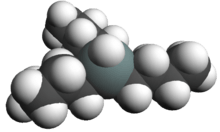Tributyltin

Tributyltin (TBT) compounds are a group of compounds containing the (C4H9)3Sn moiety, such as tributyltin hydride or tributyltin oxide. They are the main active ingredients in certain biocides used to control a broad spectrum of organisms. These compounds are included in the Rotterdam Convention[1] and have been banned by the International Convention on the Control of Harmful Anti-fouling Systems on Ships of the International Maritime Organization.[2]
Uses
Uses include wood preservation, antifouling pesticide in marine paints, antifungal action in textiles and industrial water systems, such as cooling tower and refrigeration water systems, wood pulp and paper mill systems, and breweries. Tributyltin oxide is the most widely used compound in TBT–containing commercial products.
In the chemical laboratory, tributyltin hydride generated by the action of lithium aluminium hydride on tributyltin chloride is used to replace halogens in organic compounds for hydrogen.
Toxicity
TBT compounds are considered toxic chemicals which have negative effects on humans and the environment.[1] Tributyltin compounds are moderately to highly persistent organic pollutants that biomagnify up the marine predators' food net. One common example is leaching of TBT from marine paints into the aquatic environment, causing irreversible damage to the aquatic life. Tributyltin has also been linked to obesity in humans, as it triggers genes that cause the growth of fat cells.[3]
TBT is harmful to some marine organisms, including the dog whelk. TBT causes dog whelks to suffer from imposex: females develop male sexual characteristics such as a penis.[4] Trace amounts of just 2.4 nanograms of TBT per litre are needed to produce sexual changes in dog-whelks.[2] This causes them to become infertile or even die. In severe cases males can develop egg sacs.
Tributyltin, dibutyltin and toxicity to marine mammals
Studies have shown that wild, dead sea otters (Enhydra lutris) and stranded bottlenose dolphins can have extremely high levels of tributyltin in their livers.[5] Both tributyltin and dibutyltin, a metabolite byproduct, cause immunosuppression, leading to secondary infections.[citation needed] This was supported by the finding that otters dying of infectious causes tend to have higher levels of tissue butyltins than those dying of trauma or other causes.[6]
TBT has also been blamed by hearing experts for causing hearing loss in mammalian top predators such as toothed whales.[7][8]
Tributyltin toxicity to marine invertebrates
TBT is extremely toxic to molluscs.[1] In the case of bivalve larvae, the effective concentration (EC50) of TBT is 1000 times lower than that of any other toxic compound introduced into the marine environment.[9] TBT also causes imposex in marine gastropods[1] and is probably responsible for reductions in their populations in zones with important ship traffic.[10]
Concerns over toxicity of these compounds have led to a worldwide ban by the International Maritime Organization.[2] It is now considered a severe marine pollutant.
Further bioeffects
TBT compounds have been described to interfere with glucocorticoid metabolism, by inhibiting the activity of the enzyme 11beta-hydroxysteroiddehydrogenase type 2, which converts cortisol to cortisone.[11]
See also
- Triphenyltin
- Organotin chemistry
- Bottom paint
References
- ↑ 1.0 1.1 1.2 1.3 Secretariat for the Rotterdam Convention on the Prior Informed Consent Procedure for Certain Hazardous Chemicals and Pesticides in International Trade (1 February 2009). "Decision Guidance Document for Tributyltin Compounds". United Nations Environment Programme. Retrieved 2013-01-04.
- ↑ 2.0 2.1 2.2 "Focus on IMO - Anti-fouling systems". International Maritime Organisation.
- ↑ Staff (2008-12-03). "Persistent Pollutant May Promote Obesity". Science daily. Retrieved 2008-12-03.
- ↑ Dan Minchin, Eberhard Stroben, Jörg Oehlmann, Barbara Bauer, Colm B. Duggan and Michael Keatinge (1996). "Biological indicators used to map organotin contamination in Cork Harbour, Ireland". Marine Pollution Bulletin 32 (2): 188. doi:10.1016/0025-326X(95)00120-C.
- ↑ Murata S, Takahashi S, Agusa T, Thomas NJ, Kannan K, Tanabe S (April 2008). "Contamination status and accumulation profiles of organotins in sea otters (Enhydra lutris) found dead along the coasts of California, Washington, Alaska (USA), and Kamchatka (Russia)". Marine pollution bulletin 56 (4): 641–9. doi:10.1016/j.marpolbul.2008.01.019. PMID 18304586.
- ↑ Kannan et al. 1998. Butyltin residues in Southern sea otters (Enhydra lutris nereis) found dead along California coastal waters. Environ. Sci. Technol. 32:1169-1175
- ↑ Matt Apuzzo (2005-01-28). "Whale Deafness Linked To Chemical". Associated Press via CBS News. Retrieved 2008-07-30.
- ↑ Santos-Sacchi Joseph, Song Lei, Zheng Jiefu, Nuttall Alfred L (2006-04-12). "Control of Mammalian Cochlear Amplification by Chloride Anions". Journal of Neuroscience 26 (15): 3992–3998. doi:10.1523/JNEUROSCI.4548-05.2006. PMID 16611815.
- ↑ see Fig.15 on p. 134 in: His E, Beiras R, Seaman MNL (1999). "The assessment of marine pollution: bioassays with marine embryos and larvae". Advances in marine biology. Advances in Marine Biology 37: 1–178. doi:10.1016/S0065-2881(08)60428-9. ISBN 978-0-12-026137-6.
- ↑ http://smithsonianrex.si.edu/index.php/scms/article/view/461/420
- ↑ Atanasov AG, Nashev LG, Tam S, Baker ME,Odermatt A. Organotins disrupt the11beta-hydroxysteroid dehydrogenase type2-dependent local inactivation ofglucocorticoids. Environ Health Perspect.2005 Nov;113(11):1600-6. PubMed PMID:16263518; PubMed Central PMCID: PMC1310925.http://www.ncbi.nlm.nih.gov/pubmed/16263518
External links
- Newcastle University Biofouling Group
- "Ambient Aquatic Life Water Quality Criteria for Tributyltin (TBT)" United States Environmental Protection Agency, December 2003
